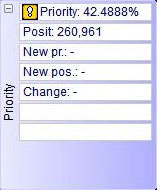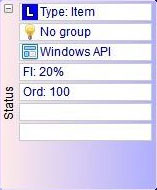The Element data window can most conveniently be viewed by pressing F5 (Window : Layout : Warrior layout). Note that you can collapse/expand individual data groups, and save your arrangement in a custom window layout.
Figure: The Element data window for an item about the Pascal programming language. In the presented example, the element is listed at position #51450 in the collection and its title is "Pascal: What function returns a predecessor of an ordinal variable?". Element titles are automatically generated from the first question text.
Available element data groups
Priority
Dates
- Next
- date when the next repetition of the element should take place. In the picture, the next repetition has been scheduled for Apr 29, 2016. Elements which are due for review on a given day have their next repetition date additionally prefixed with Now:
- Last
- date of the last repetition. The last repetition took place on Mar 12, 1997.
- Time
- time of the last repetition. The precise time of the last repetition is unavailable since this piece of data has started being collected only with SuperMemo 13 (2006).
- First
- first repetition ever recorded in the repetition history (usually also: first ever repetition). The first repetition recorded in this item's repetition history was made on Mar 12, 1997. Warning! Items repeated before 1996 may not carry repetition history record and the first repetition on the list may not be the first repetition ever made. In this particular case, the item was repeated 7 times before 1997. This information can be inspected only in the element's Repetition history window (e.g. available with Ctrl+Shift+H).
- Posit
- position of the element in the outstanding queue. Here the item is the 3,147th element in the queue of 9,073 outstanding elements scheduled for review on Apr 29, 2016.
- Workload
- the number of elements due for review on the next repetition date. There have been 9,073 elements scheduled for review on Apr 29, 2016.
|  |
Interval
DSR Stats
- S
- item's current stability expressed as the optimum interval in spaced repetition. In the picture, the stability for the item amounts to 18 years 9 months and 19 days. It might be lower than the current interval due to multiple postpones
- R
- item's retrievability estimated at the moment of the repetition. The probability of recall of the item after the scheduled interval of 18 years 9 months and 19 days stands at 89.8%
- SInc
- best estimate of the item's stability increase. Here the item's stability (expressed as the optimum interval) is estimated to best increase at a factor of 1.5151 (i.e. 51%) after the repetition.
- SInc[]
- entry in the stability increase matrix. Based on the corresponding entry in the stability increase matrix, after the repetition the item's stability is expected to increase by a factor of 1.1711 (i.e. 17%). Note that where data is scarce (e.g. as in this case of unusually long interval), the difference between SInc[] and SInc may be large due to a larger impact of neighboring entries and the theoretical prediction based on the SInc approximation.
- Next S
- item's expected new stability after the scheduled next repetition.
Next S=S*SInc. The new stability (i.e. optimum interval) of the item repeated on Apr 29, 2016 after the interval of 19 years 1 month and 18 days is expected to be 10,403 days. - Next R
- item's expected retrievability after the next optimum interval passes. The expected retrievability (i.e. probability of recall) of the item at the next repetition in 10,403 days stands at 89.8%.
|  |
Repetitions
- Reps
- number of repetitions of the displayed element. For items, once the item is forgotten, the count of repetitions begins from scratch (i.e. Reps equals 1 again). In the enclosed example, the item has been repeated with a passing grade 8 successive times.
- Lapses
- number of memory lapses. 0 lapses means the item has never been forgotten before."
- Grade
- grade used in the optimization procedure (the value used in parentheses shows the recent grade given by the user, which can be overridden in rare circumstances)
- Postpones
- total and recent number of times the element has been postponed. The presented item has been postponed 174 times since the last repetition, and 180 times in its lifetime. In this case, 6 postpones occurred since total postpone count begun as a result of implementing this new statistic in SuperMemo 17.
- Future
- estimated number of repetitions of the item in the next 30 years. Future value is easily derived from the DSR model. For topics, the number of presentations depends on A-Factor only. Note that the value is the estimate from before the execution of a repetition. After the repetition, the estimate is likely to go to zero, meaning, this item became a part of "permastore" (i.e. it might be remembered till the end of an average life). SuperMemo roughly predicts that there will still be 1 repetition of the presented item in the next 30 years.
- Future Sec
- time needed for executing the estimated number of repetitions (Future) of the item in the next 30 years.
Future Sec=Future*Avg time. The Statistics window's Avg time parameter makes it possible to estimate the cost of retaining the presented item in memory until 2046 is 9 seconds on the assumption it will not be forgotten in the meantime. - U-Factor
- quotient of the previous interval and the next interval. In items that have been repeated only once, U-Factor equals the first interval (in days). Here U-Factor is 4.795.
|  |
Difficulty
- Diff
- current estimation of the item's absolute difficulty estimated by Algorithm SM-17. This number ranges from 0 (for easy items) to 1 (for difficult ones). In the picture, the item's difficulty is estimated to be at 0.0% which means it is very easy to remember.
- Old
- heuristic measure of the item's difficulty known from SuperMemo 16 or earlier. It is estimated on the basis of the following parameters: Interval, Lapses, Repetitions, A-Factor, and First grade. The theoretical minimum for the difficulty is 0% and the theoretical maximum is 100%. This number decreases gradually with successful repetitions. Conversely, it increases with memory lapses. In a typical collection, the difficulty of items usually ranges from 16% to 64%. If the difficulty reaches beyond 65% you should have a closer look at the formulation of the item (e.g. memory interference, ambiguity, excessive wording, complex answer, etc.). See also: 20 rules of formulating knowledge. Here the item is estimated to be at 18.4% difficulty which indicates it is relatively easy to remember.
- A-Factor
- A-Factor associated with the current element. In Algorithm SM-15, A-Factor is a rough measure of item difficulty and a measure of the rate at which inter-repetition intervals increase. The higher the A-Factor, the faster the increase in intervals. The most difficult items have A-Factor equal to 1.2 while the easiest ones 6.9. For topics, concepts and tasks, A-Factors equal the increase in interval in a single review and may be as low as 1.01. Note that Diff (above) is much more an accurate measure of item difficulty (as perceived by the user). A-Factor of 4.307 indicates that the item is relatively easy to remember.
|  |
Status
- Difficulty - show the estimation of the element's difficulty
- Next window (Ctrl+F6) - switch to the next window
- Element window (Esc) - shift focus to the element window
- Format intervals - format intervals as years, months, days, etc. If the formatted interval no longer fits within the field, click the field to display its entire value in a dialog box. Alternatively, hover the mouse over the field and read its value from the yellow hints panel in the status bar (Window : Hints must be checked for it to work).
Further reading







